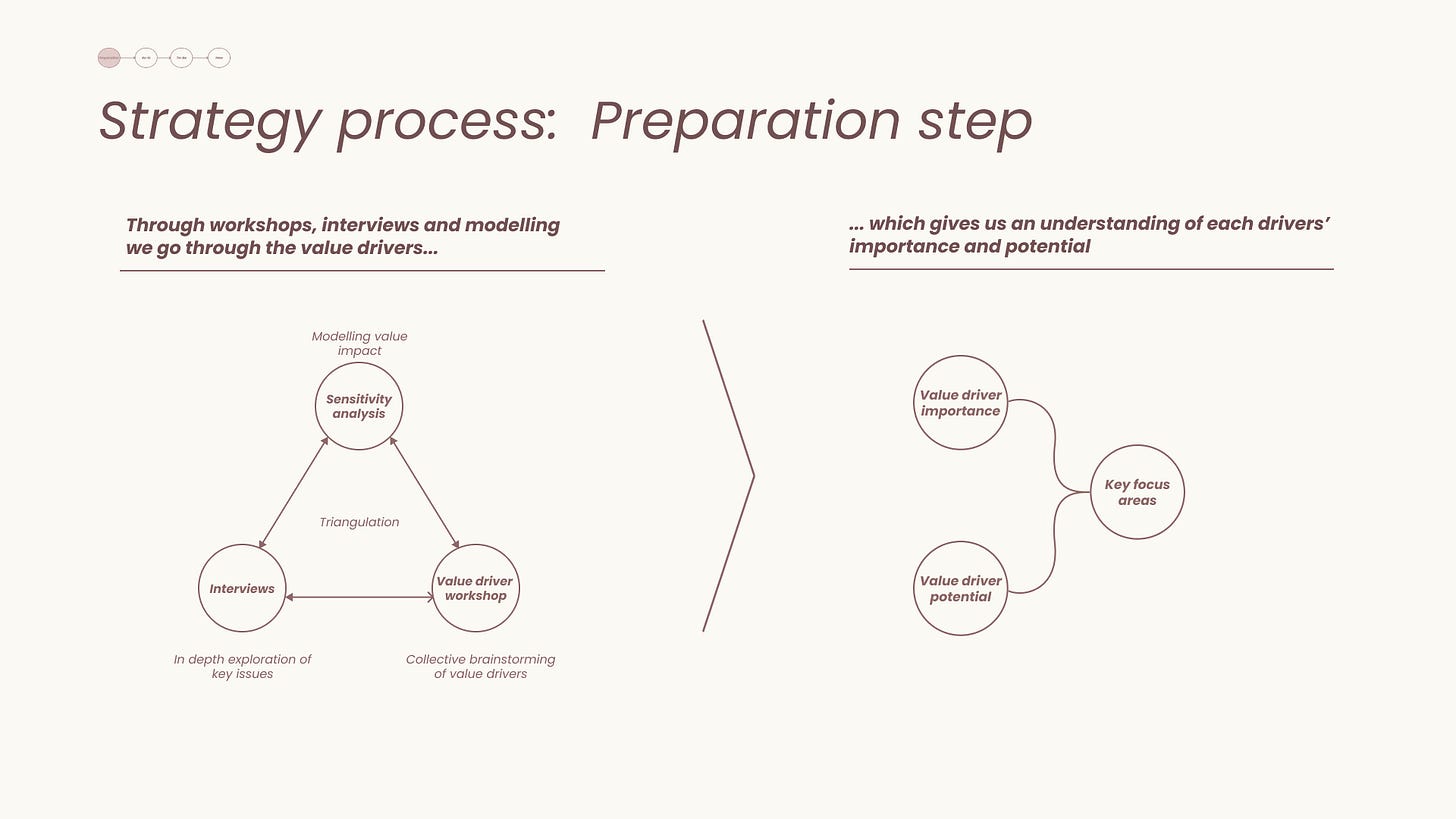How To Prepare For The Strategy Process
Preparation is one of the highest leverage parts of the strategy process.
In sports, preparation often dictates how the game unfolds.
In strategy, its the same thing. Preparation primes the participants for the game ahead. Excellent preparations is the difference between a problem solving hive-mind and a lobotomised fluff-fest. In my experience, preparation delivers 50-80 % of the value in 10 % of the time it takes to do a strategy process.
How? By doing 3 things:
Sensitivity analysis (to understand what matters)
Value driver workshop (to systematically and collaboratively capture ideas)
Interviews (to gather nuance)
Done right, this method makes it unreasonable not to succeed.
The Goal: Create A Hive Mind Laser Focused On The Key Opportunities and Problems
The best way to fail at strategy is by failing to align the team on key issues.
The preparation step sets the tone for the entire process. Done well, you trigger the navy seal flow state. A hive-mind laser focused on the most important issues. People understand what and why you are doing certain things. They clearly see how their effort contributes to the process. People proactively contribute ideas between meetings and workshops. Things move quickly and swiftly. It’s intense in the best possible way.
Constrast this to a badly prepared strategy process.
People roll their eyes. Don’t buy in. It feels like a waste of time. When preparation is bad, the process drifts into fluffy nonsense. With no alignment on key issues, low engagement, and an almost hopeless task of saving the process on the back-end.
Prep well, or your strategy process goes to hell.
How To Prepare And Prime The Team
Preparation requires a blend of hard-core strategy skills and social psychology.
Here’s how:
Sensitivity analysis, so that you know the drivers of the business and can effectively do steps 2+3
Value driver workshop, so that you have a structured way of capturing everyone’s ideas in front of everyone
Interviews, so that you capture the essential nuance of each issue
The sequence matters a lot, because each step builds on the last.
Step 1: Sensitivity Analysis
If you don’t understand the drivers, you’ll drive in the wrong direction.
Period.
That’s why the value driver framework is invaluable. You should understand the impact of raising prices by 20 % on product Y, increasing the number of customers by 50%, or reducing fixed costs by 10 %. Otherwise, you stand no chance at filtering, challenging or otherwise evaluate the ideas that come up in interviews or workshops (steps 2 and 3). And if you cannot steer the discussion away from low-impact ideas, you’ll waste everyones time.
And you cannot steer before you understand the economics of the business.
Step 2: The Value Driver Workshop
This step should be considered cheating, because it is so effective.
What is it? A 2-3 hour workshop with the team where you brainstorm ideas and map them to the value drivers of the company. Below is an illustration.
(Note: you don’t need to go all the way down. You can keep it simple at levels 2 or 3 if you are starting out)
The goal? Capture any idea the team has. Anything goes. Whether it is an opportunity, a problem, or a risk. Encourage the team to empty their brains. Place each idea on the value driver tree. Do this on a screen, collaboratively, so that everyone can see what’s going on. Spend 1-5 minutes on each idea. You want to understand what the idea really is about, what the benefit could be and what you think the solution requires.
This achieves several neat things:
It teaches the team about value drivers
It creates alignment, because it’s their ideas
It forces cross-functional collaboration
It plants seeds for later work in the process
To pull this off: you need to be able to map ideas to value drivers. And gracefully steer the discussion towards things that move the needle. Challenge, but encourage. To do this on the spot, you should understand the drivers and sensitivities of the business. Hence the first step.
Step 3: Interviews
Interviews are a wealth of information.
Time and time again, I’ve found the most useful insights in conversations. The team know the business and its problems in and out. If you do this well, you’ll build trust and get tons of ideas and insights. If you conduct yourself badly, you’ll be shut out and struggle with the strategy process.
Interviews is the perfect place to get nuance.
You can go deeper on the key issues identified in the value driver workshop. Most managers enjoy this, because they get to talk for an extended period of time about what they do. You should discuss hypotheses for root causes, and think about what can be done to solve these.
What are the critical success factors?
Prepare well
Send the interview form well in advance
Treat everything as confidential
Highlight the importance of openness.
Be humble.
Never judge.
Appreciate nuance.
Also appreciate how randomness plays a huge part in how things have come to be.
Take EXTENSIVE notes. And process the notes immediately after the interview.
Conclusion
A well executed prep step is rocket fuel to strategy.
If you do it well, it becomes unreasonable for team members not to put their best foot forward. When you gather the team’s ideas, collaboratively process them in front of everyone, and listen to their individual input 1-on-1, you’ll have have gathered 70-80 % of the information you need for the overall process.
And perhaps even more importantly, it plants seeds that grow as you continue the process and learn more about each issue.




Great read, Alex! Excellent and highly actionable blueprint!
Love the simplicity of laying down this process.